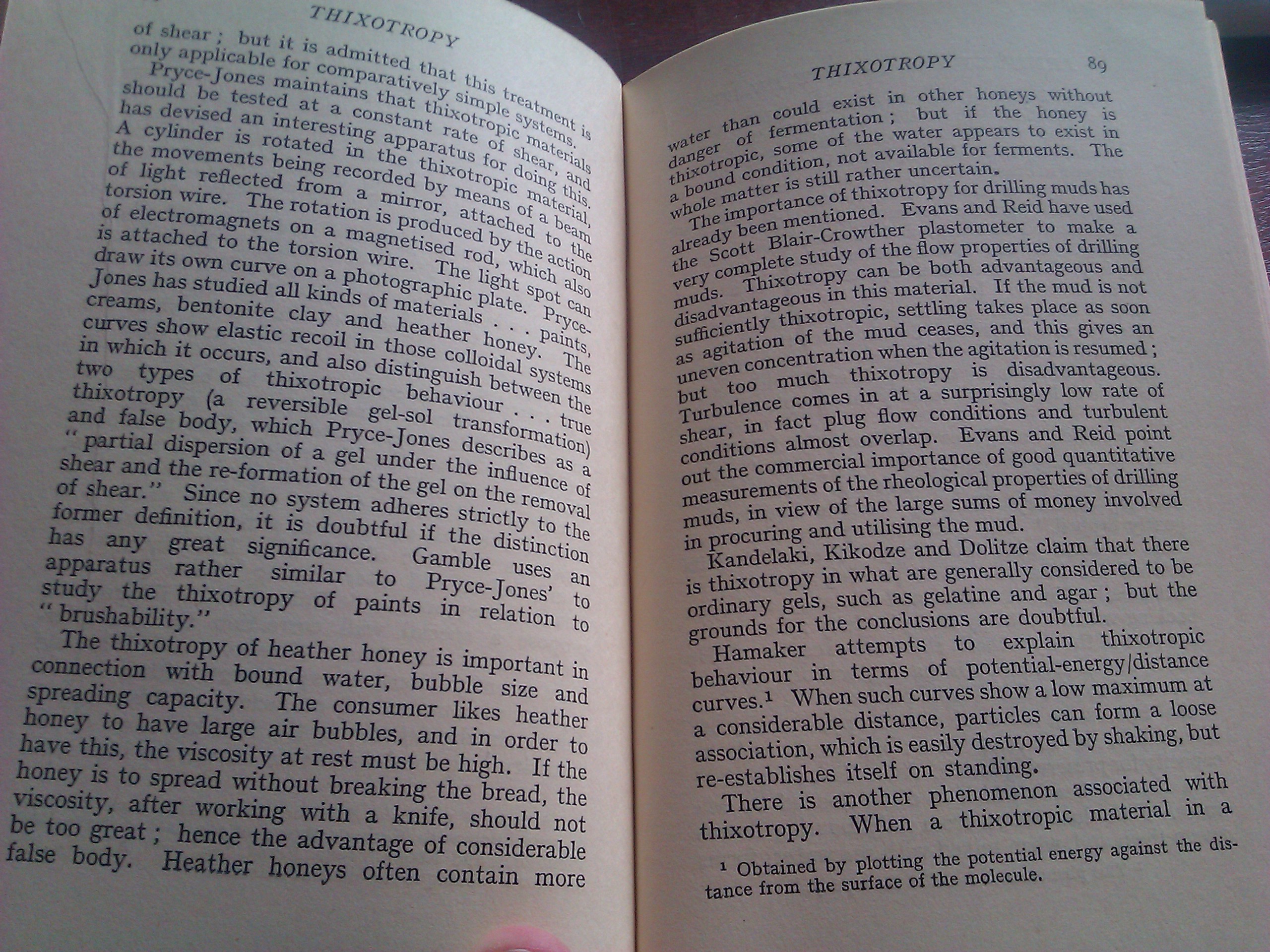str (95)

of sbear ; but it is admitted that thia treat only applicable for COmparatively simple sys?1*114 U Pryce-Jon es maintains that thixotropic rn6?13- I should be tested at a constant ratę of shea c'ah 1 lias deyised an interesting aipparatus for do®1’
A cylinder is rotated in the j4SJdxotropic 1
the movements being recorded by means of a 1 of light reflected from a tnirror, attaohed tofB torsion wire. The rotation is produced by the acti I of electromagnets on a mpgnetised rod,.which af*1 1 is attached to the torsion wire. The light spot cf° I draw its own curve on a photographic piąte. Try^ Jones has studied all kinds of rnaterials . . . paints, creams, bentonite clay and heather honey. The curves show elastic recoil in those colloidal Systems in which it occurs, and also distinguish between the two types of thixotropic behaviour . . . thixotropy (a xeversible gel-sol tfeasformation) and false body, which Pryce-Jones describes as a | partial dispersion of a gel under the influence o{ shear and the re-formation of the gel on the yemoval of shear." Since no system adheres strictly to the form er definition, it is doubtful if the pjistinction has any great significance. Gamble uses an apparatus rather similar to Piyce-Jones’ to
study the thixotropy of paints in relation to
" broshabiiity.”
The thixotropy of heather honey is important in connection with botind water, bubble^ size and spreading capacity. The consumer likes heather honey to have large air bubbles, and in order to have this, the viscosity at rest must be high.?! If the honey is to spread without breaking the bread|the viscosity, after working with a knife, should net be too great; hence the advantage of 'Considerable false body. Heather honeys often contain morę
mmmm ^
than could exist in other honeys without v/*tetr 0f fermentation; but if the honey is ^tropie, some of the water appears to exist in tb?und cońdition, not available for ferments. The 9H matter is still rather uncertain.
W The importance of thixotropy for drilling muds has iready heen mentioned. Evans and Reid have used ?he Scott Blair-Crowther plastometer to make a complete study of the flow properties of drilling jauds. Thixotropy can be both advantageous and (jisadvantageous in this materiał. If the mud is not sufficiently thixotropic, settling takes place as soon as agitation of the mud ceases, and this gives an uneven concentration when the agitation is resumed; but too much thixotropy is disadvantageous. Turbulence comes in at a surprisingly Iow ratę of shear, in fact pług flow conditions and turbulent conditions almost overlap. Evans and Reid point out the commercial importance of good quantitative measurements of the rheological properties of drilling muds, in view of the large sums of money invołved in procuring and utilising the mud.
Kandelału, Kikodze and Dolitze claim that there
is thixotropy in what are generally considered to be ordinary gels, such as gelatine and agar; but the grounds for the condusions are doubtful.
Hamaker attempts to explain thixotropic behaviour in terms of potential-energy/distance curyes.1 When such curves show a Iow maximum at a considerable distance, particles can form a loose association, which is easily destroyed by shaking, but re-establishes ltself on standing.
There is another phenomenon associated with thixotropy. When a thixotropic materiał in a
Obtained by plotting the potential energy against the dis-tance from the surface of the molecule.
Wyszukiwarka
Podobne podstrony:
1.2. Goal and Plan of the Work 3 It is assumed that the goal of this work can be reached in the foll
DSC07986 (2) rctchiiif condiuions conccming cithcr thc prcvalenee or absence oi somę. of deposit. Ho
m85@ examples of these are illustrated in the tapestry but it is not possible to interpret the
Ask Me Everythinga Screaming wind The eye of a hurricane is strangely calm, but it is surrounded by
ProcessSection CDisplay of permits It is important that permits are displayed so the persons who nee
IMGx51 274 The Origin of Civitisation cultural behaviour of modern man. It is thus entirely consiste
mb 41 MUSCLE BUILDINC. Ą łax the ill of most men; it is sliort onoiigli to be wit
mbs 125 MY BRFATHING SYSTEM thus be performed vcry quickly, which is often necessaiy, but it is real
f O i oGD my 15:39BooksNotes App @ living an unrestrained life is easy, but it is
15 5 Ceremoniał closing of negotiations. After finishing serious and important negotiations, it is e
17.7.2000 lENl Official Journal of the European Communities L 178/7 (50) It is important that t
17.7.2000 lENl Official Journal of the European Communities L 178/7 (50) It is important that t
Advantages and disadvantages of digital education 27 Among the concems on the ąuality of education i
więcej podobnych podstron